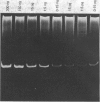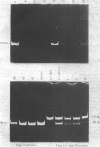Abstract
The polymerase chain reaction is an in vitro method for primer directed enzymatic amplification of specific target DNA sequences. The technique was used to detect human papillomavirus types 11 and 16 simultaneously in cellular DNA recovered from cervical smears in 38 women referred for colposcopy to evaluate cytological abnormality and 10 women with no history of cytological abnormality. The polymerase chain reaction was shown to be both specific and sensitive in detecting human papillomavirus DNA such that a single human papillomavirus molecule was detected in 10(5) cells. Of the 38 women with cytological abnormality, all were positive for human papillomavirus on testing with the polymerase chain reaction; 36 were infected with human papillomavirus type 16 and 22 dually infected with human papillomavirus types 11 and 16. Seven of the 10 women with no cytological abnormality were also infected with human papillomavirus type 11 or 16. The use of the polymerase chain reaction will facilitate epidemiological investigation of the aetiological role of human papillomavirus in cervical neoplasia. This preliminary analysis suggests that the prevalence of human papillomavirus infection is greater than previously reported.
Full text
PDF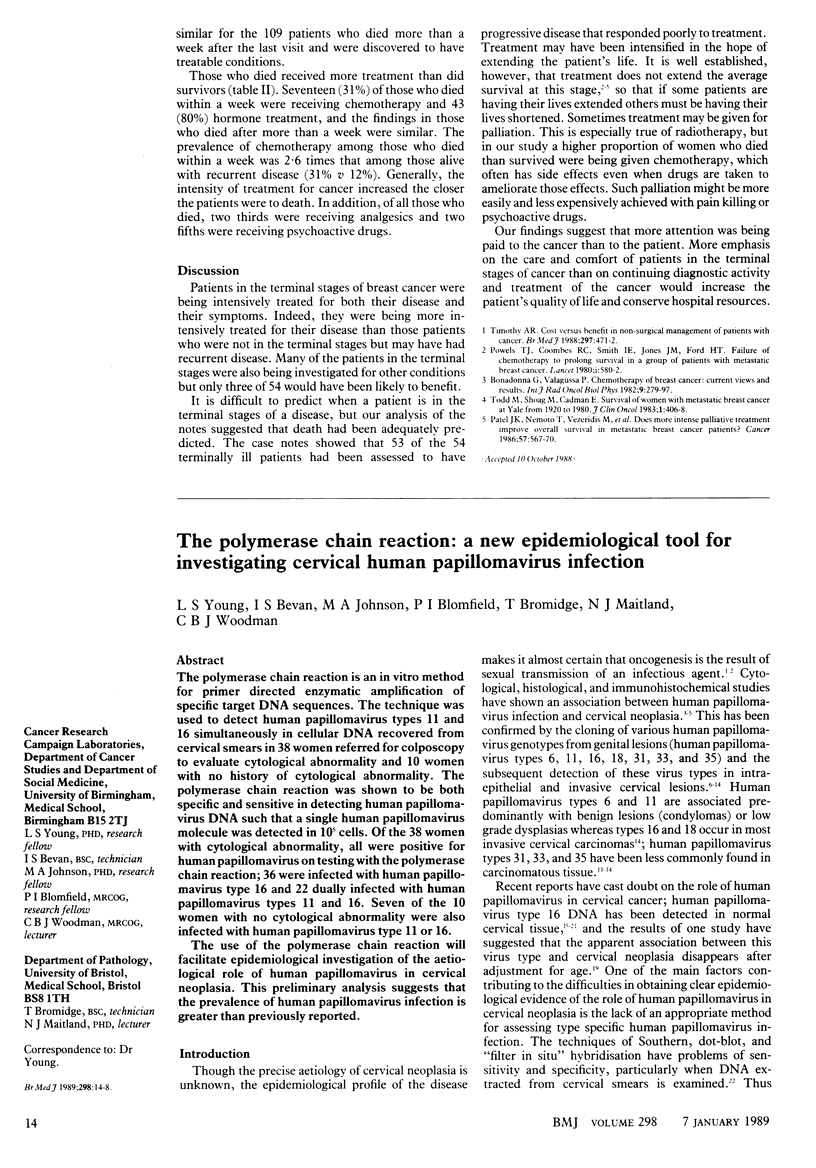
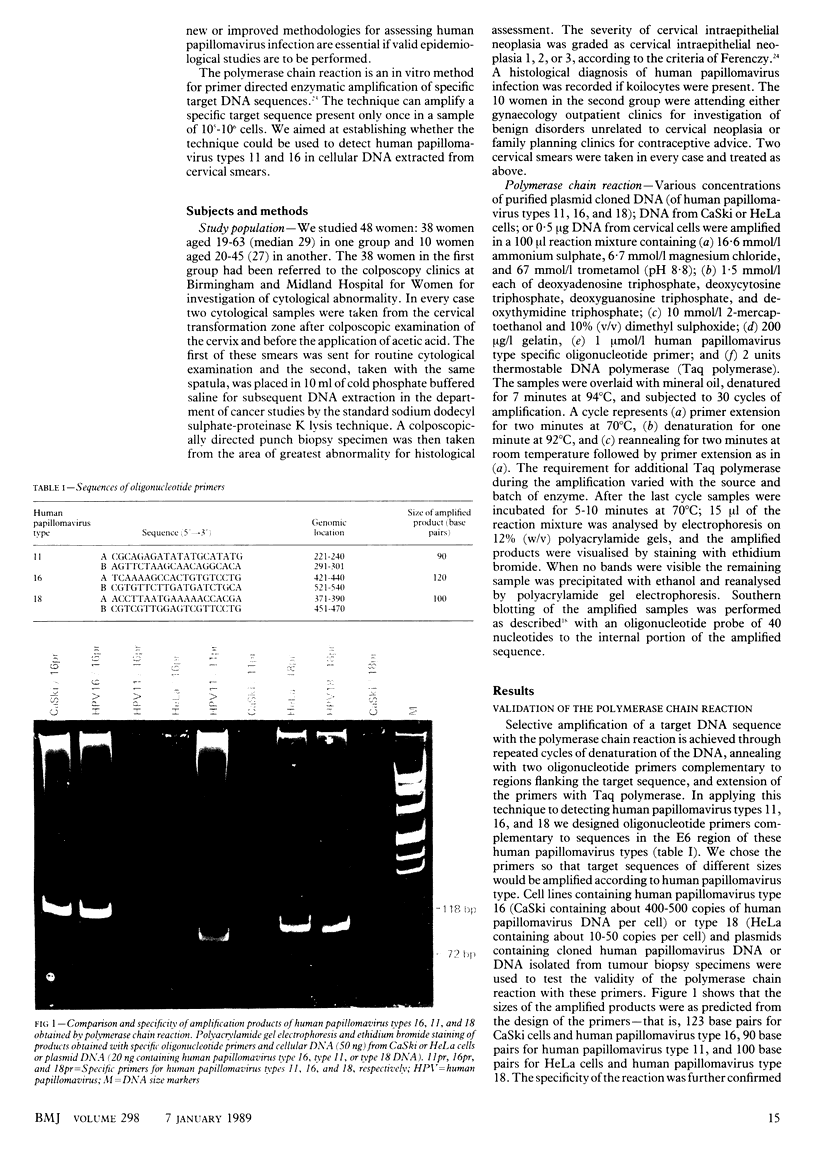
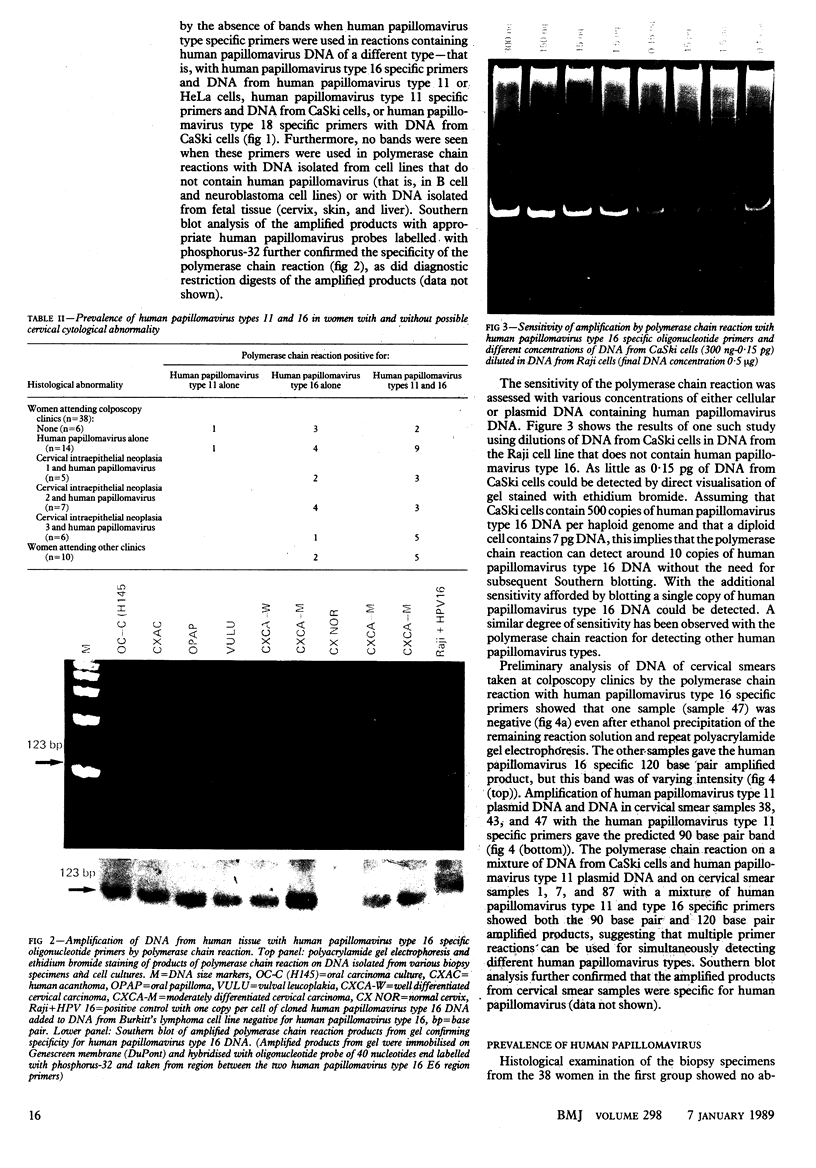
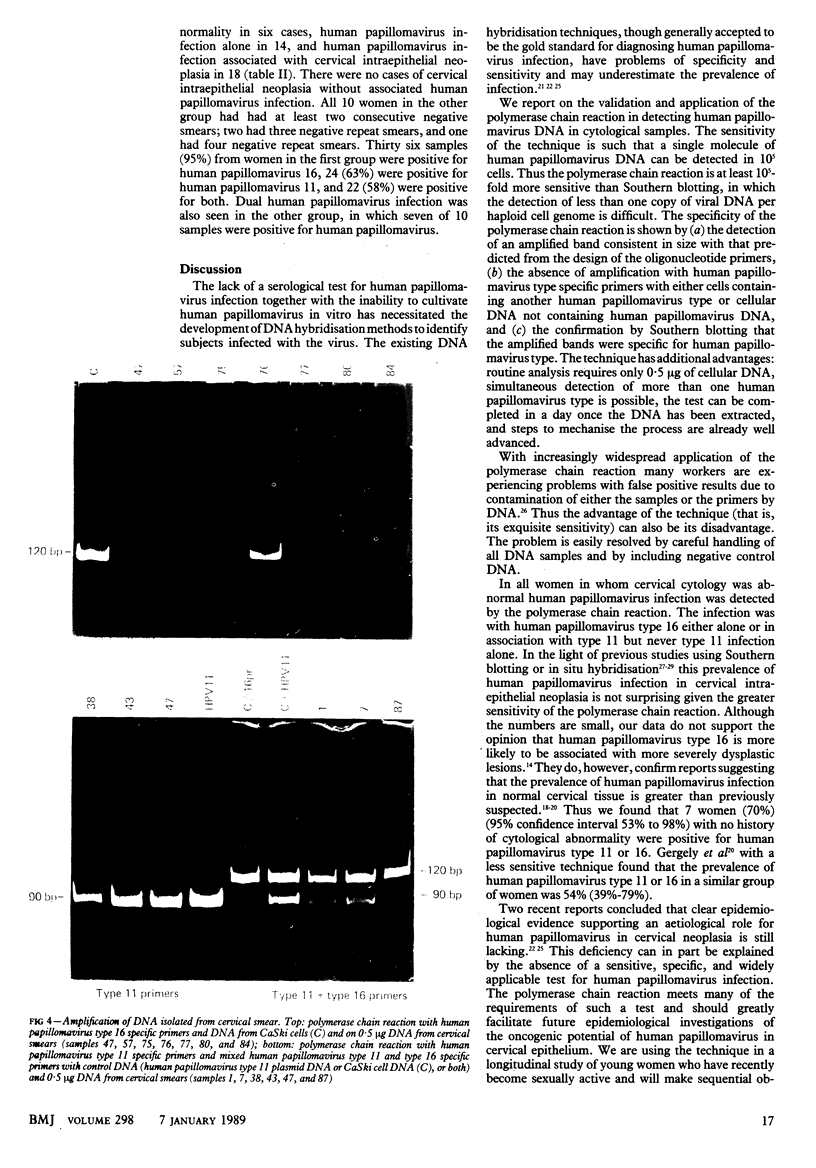
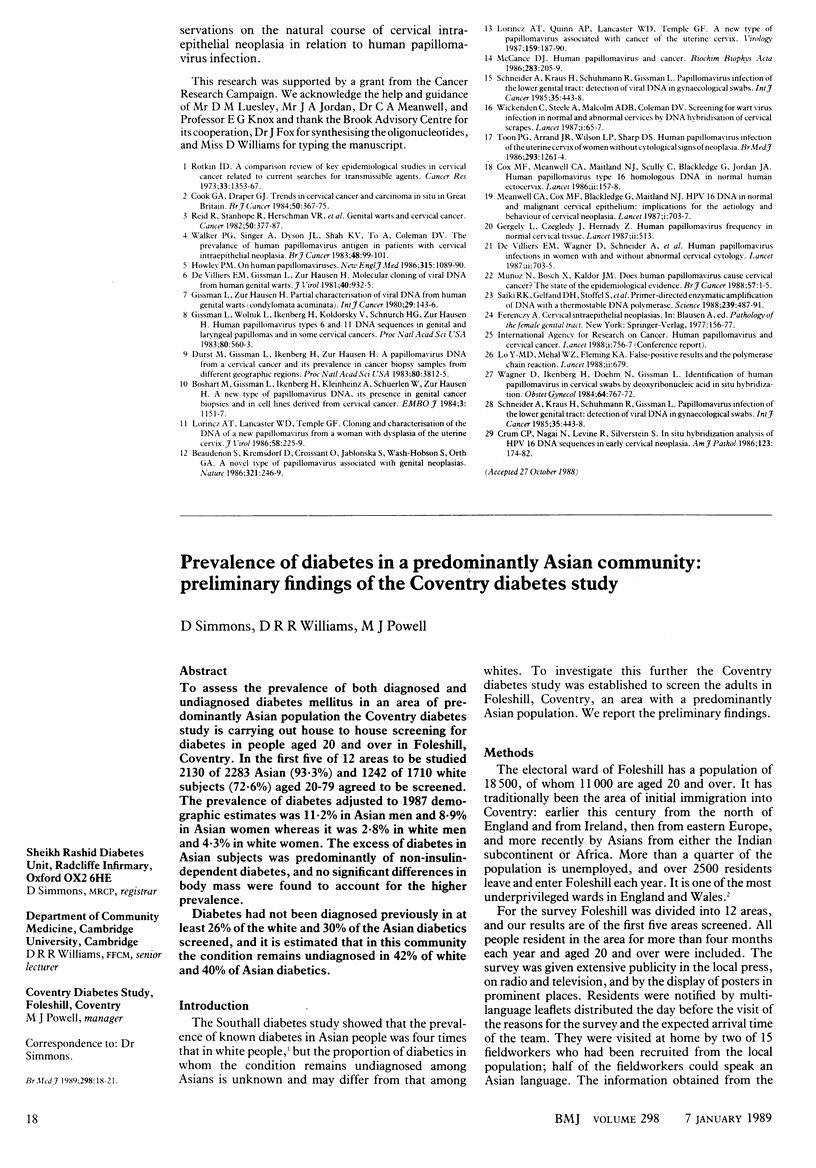
Images in this article
Selected References
These references are in PubMed. This may not be the complete list of references from this article.
- Beaudenon S., Kremsdorf D., Croissant O., Jablonska S., Wain-Hobson S., Orth G. A novel type of human papillomavirus associated with genital neoplasias. Nature. 1986 May 15;321(6067):246–249. doi: 10.1038/321246a0. [DOI] [PubMed] [Google Scholar]
- Cook G. A., Draper G. J. Trends in cervical cancer and carcinoma in situ in Great Britain. Br J Cancer. 1984 Sep;50(3):367–375. doi: 10.1038/bjc.1984.185. [DOI] [PMC free article] [PubMed] [Google Scholar]
- Cox M. F., Meanwell C. A., Maitland N. J., Blackledge G., Scully C., Jordan J. A. Human papillomavirus type-16 homologous DNA in normal human ectocervix. Lancet. 1986 Jul 19;2(8499):157–158. doi: 10.1016/s0140-6736(86)91965-3. [DOI] [PubMed] [Google Scholar]
- Crum C. P., Nagai N., Levine R. U., Silverstein S. In situ hybridization analysis of HPV 16 DNA sequences in early cervical neoplasia. Am J Pathol. 1986 Apr;123(1):174–182. [PMC free article] [PubMed] [Google Scholar]
- Dürst M., Gissmann L., Ikenberg H., zur Hausen H. A papillomavirus DNA from a cervical carcinoma and its prevalence in cancer biopsy samples from different geographic regions. Proc Natl Acad Sci U S A. 1983 Jun;80(12):3812–3815. doi: 10.1073/pnas.80.12.3812. [DOI] [PMC free article] [PubMed] [Google Scholar]
- Gergely L., Czeglédy J., Hernády Z. Human papillomavirus frequency in normal cervical tissue. Lancet. 1987 Aug 29;2(8557):513–513. doi: 10.1016/s0140-6736(87)91824-1. [DOI] [PubMed] [Google Scholar]
- Gissmann L., Wolnik L., Ikenberg H., Koldovsky U., Schnürch H. G., zur Hausen H. Human papillomavirus types 6 and 11 DNA sequences in genital and laryngeal papillomas and in some cervical cancers. Proc Natl Acad Sci U S A. 1983 Jan;80(2):560–563. doi: 10.1073/pnas.80.2.560. [DOI] [PMC free article] [PubMed] [Google Scholar]
- Lo Y. M., Mehal W. Z., Fleming K. A. False-positive results and the polymerase chain reaction. Lancet. 1988 Sep 17;2(8612):679–679. doi: 10.1016/s0140-6736(88)90487-4. [DOI] [PubMed] [Google Scholar]
- Lorincz A. T., Lancaster W. D., Temple G. F. Cloning and characterization of the DNA of a new human papillomavirus from a woman with dysplasia of the uterine cervix. J Virol. 1986 Apr;58(1):225–229. doi: 10.1128/jvi.58.1.225-229.1986. [DOI] [PMC free article] [PubMed] [Google Scholar]
- Lorincz A. T., Quinn A. P., Lancaster W. D., Temple G. F. A new type of papillomavirus associated with cancer of the uterine cervix. Virology. 1987 Jul;159(1):187–190. doi: 10.1016/0042-6822(87)90366-7. [DOI] [PubMed] [Google Scholar]
- McCance D. J. Human papillomaviruses and cancer. Biochim Biophys Acta. 1986;823(3):195–205. doi: 10.1016/0304-419x(86)90002-8. [DOI] [PubMed] [Google Scholar]
- Meanwell C. A., Cox M. F., Blackledge G., Maitland N. J. HPV 16 DNA in normal and malignant cervical epithelium: implications for the aetiology and behaviour of cervical neoplasia. Lancet. 1987 Mar 28;1(8535):703–707. doi: 10.1016/s0140-6736(87)90353-9. [DOI] [PubMed] [Google Scholar]
- Reid R., Stanhope C. R., Herschman B. R., Booth E., Phibbs G. D., Smith J. P. Genital warts and cervical cancer. I. Evidence of an association between subclinical papillomavirus infection and cervical malignancy. Cancer. 1982 Jul 15;50(2):377–387. doi: 10.1002/1097-0142(19820715)50:2<377::aid-cncr2820500236>3.0.co;2-a. [DOI] [PubMed] [Google Scholar]
- Rotkin I. D. A comparison review of key epidemiological studies in cervical cancer related to current searches for transmissible agents. Cancer Res. 1973 Jun;33(6):1353–1367. [PubMed] [Google Scholar]
- Saiki R. K., Gelfand D. H., Stoffel S., Scharf S. J., Higuchi R., Horn G. T., Mullis K. B., Erlich H. A. Primer-directed enzymatic amplification of DNA with a thermostable DNA polymerase. Science. 1988 Jan 29;239(4839):487–491. doi: 10.1126/science.2448875. [DOI] [PubMed] [Google Scholar]
- Schneider A., Kraus H., Schuhmann R., Gissmann L. Papillomavirus infection of the lower genital tract: detection of viral DNA in gynecological swabs. Int J Cancer. 1985 Apr 15;35(4):443–448. doi: 10.1002/ijc.2910350405. [DOI] [PubMed] [Google Scholar]
- Schneider A., Kraus H., Schuhmann R., Gissmann L. Papillomavirus infection of the lower genital tract: detection of viral DNA in gynecological swabs. Int J Cancer. 1985 Apr 15;35(4):443–448. doi: 10.1002/ijc.2910350405. [DOI] [PubMed] [Google Scholar]
- Toon P. G., Arrand J. R., Wilson L. P., Sharp D. S. Human papillomavirus infection of the uterine cervix of women without cytological signs of neoplasia. Br Med J (Clin Res Ed) 1986 Nov 15;293(6557):1261–1264. doi: 10.1136/bmj.293.6557.1261. [DOI] [PMC free article] [PubMed] [Google Scholar]
- Wagner D., Ikenberg H., Boehm N., Gissmann L. Identification of human papillomavirus in cervical swabs by deoxyribonucleic acid in situ hybridization. Obstet Gynecol. 1984 Dec;64(6):767–772. [PubMed] [Google Scholar]
- Walker P. G., Singer A., Dyson J. L., Shah K. V., To A., Coleman D. V. The prevalence of human papillomavirus antigen in patients with cervical intraepithelial neoplasia. Br J Cancer. 1983 Jul;48(1):99–101. doi: 10.1038/bjc.1983.163. [DOI] [PMC free article] [PubMed] [Google Scholar]
- Wickenden C., Steele A., Malcolm A. D., Coleman D. V. Screening for wart virus infection in normal and abnormal cervices by DNA hybridisation of cervical scrapes. Lancet. 1985 Jan 12;1(8420):65–67. doi: 10.1016/s0140-6736(85)91963-4. [DOI] [PubMed] [Google Scholar]
- de Villiers E. M., Gissmann L., zur Hausen H. Molecular cloning of viral DNA from human genital warts. J Virol. 1981 Dec;40(3):932–935. doi: 10.1128/jvi.40.3.932-935.1981. [DOI] [PMC free article] [PubMed] [Google Scholar]
- de Villiers E. M., Wagner D., Schneider A., Wesch H., Miklaw H., Wahrendorf J., Papendick U., zur Hausen H. Human papillomavirus infections in women with and without abnormal cervical cytology. Lancet. 1987 Sep 26;2(8561):703–706. doi: 10.1016/s0140-6736(87)91072-5. [DOI] [PubMed] [Google Scholar]





